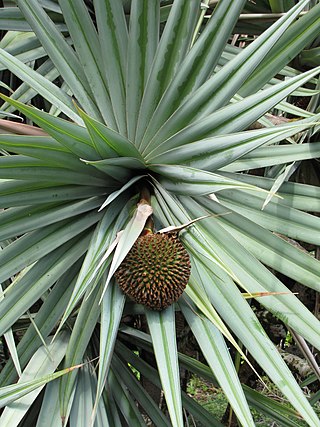
Pandanus is a genus of monocots with some 578 accepted species. They are palm-like, dioecious trees and shrubs native to the Old World tropics and subtropics. The greatest number of species are found in Madagascar and Malaysia. Common names include pandan, screw palm and screw pine. They are classified in the order Pandanales, family Pandanaceae.

Pandanus utilis, the common screwpine is, despite its name, a monocot and not a pine. It is native to Madagascar and naturalised in Mauritius and the Seychelles.
The wildlife of Mauritius consists of its flora and fauna. Mauritius is located in the Indian Ocean to the east of Madagascar. Due to its isolation, it has a relatively low diversity of wildlife; however, a high proportion of these are endemic species occurring nowhere else in the world. Many of these are now threatened with extinction because of human activities including habitat destruction and the introduction of non-native species. Some have already become extinct, most famously the dodo which disappeared in the 17th century.
Pandanus carmichaelii is a species of plant in the family Pandanaceae. It is endemic to Mauritius.
Pandanus microcarpus is a species of plant in the family Pandanaceae, endemic to Mauritius.

Pandanus palustris is a species of plant in the family Pandanaceae, endemic to Mauritius. It was once common in marshes and in the wetter highlands of Mauritius, but is now threatened by habitat loss.
Pandanus pyramidalis is a species of plant in the family Pandanaceae, endemic to Mauritius.

Pandanus vandermeeschii is a species of plant in the family Pandanaceae. It is endemic to the coastal areas of Mauritius.

Pandanus iceryi ("Vacoas") is a species of plant in the family Pandanaceae. It is endemic to Mauritius.

Pandanus spathulatus is a species of plant in the family Pandanaceae, endemic to Mauritius but possibly extinct in the wild.

Pandanus conglomeratus is a species of plant in the family Pandanaceae, endemic to Mauritius, but possibly extinct.

Pandanus drupaceus is a species of plant in the family Pandanaceae, endemic to Mauritius.

Pandanus rigidifolius is a species of plant in the family Pandanaceae, endemic to Mauritius.
Pandanus prostratus is a species of plant in the family Pandanaceae, endemic to Mauritius.

Pandanus eydouxia is a species of plant in the family Pandanaceae, endemic to Mauritius.

Pandanus glaucocephalus is a species of plant in the family Pandanaceae, endemic to Mauritius.
Pandanus barkleyi is a species of plant in the family Pandanaceae, endemic to Mauritius.
Pandanus sphaeroides is a species of plant in the family Pandanaceae, endemic to Mauritius.
Paul Octave Wiehe CBE (1910-1975) was a Mauritian botanist.
Reginald Edward Vaughan OBE FRIC was a British botanist who lived and worked in Mauritius from 1923.










